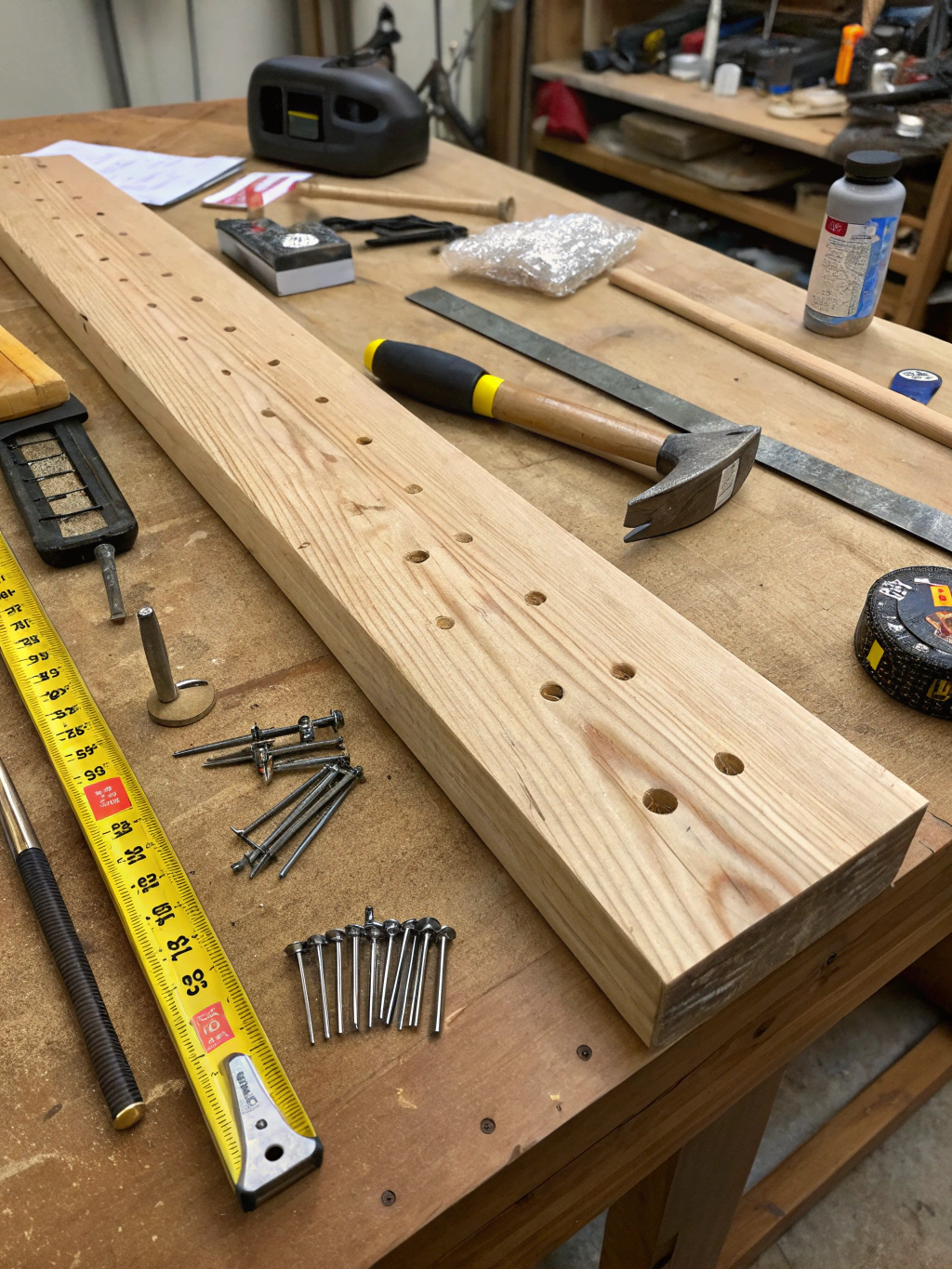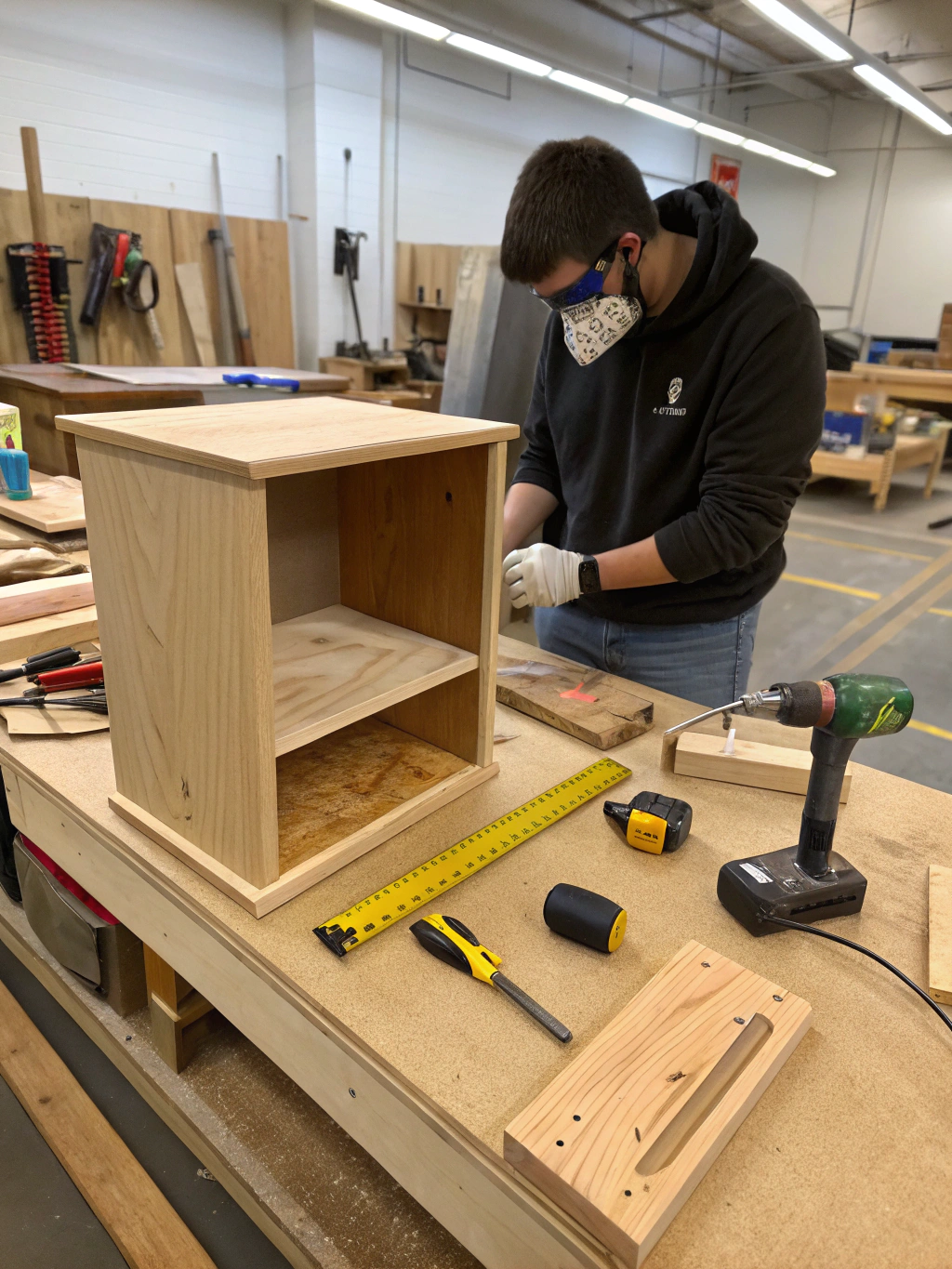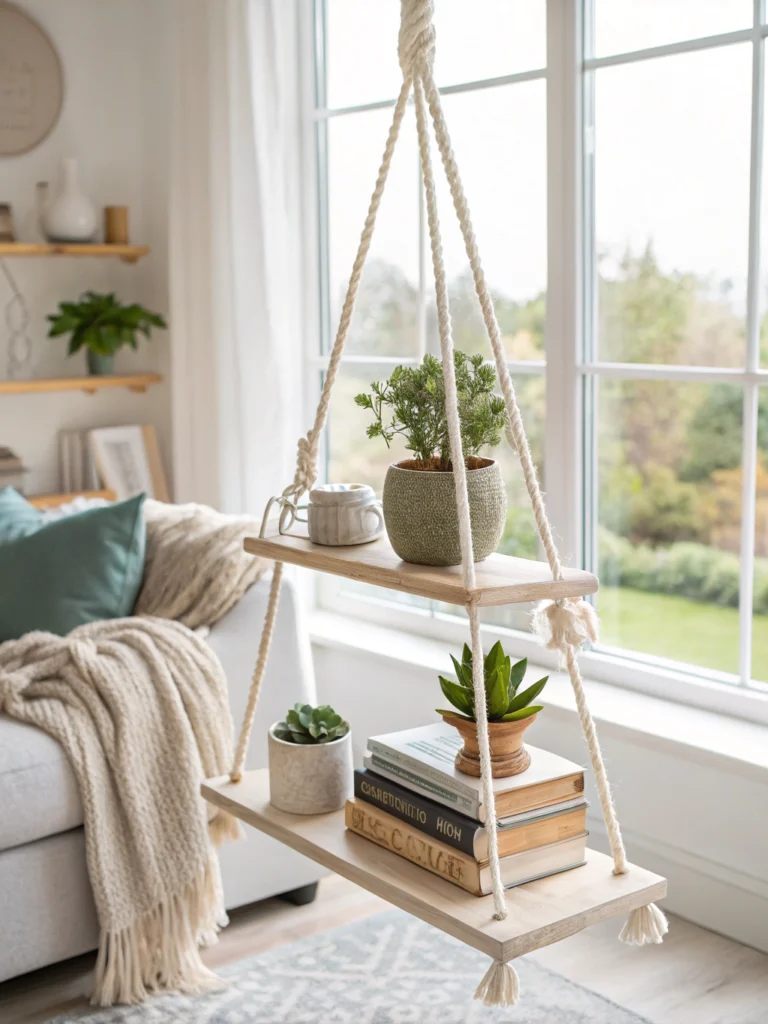Introduction
Have you ever spent weeks searching for the perfect piece of furniture, only to come up empty-handed? You know the feeling—scrolling through endless online stores, wandering through cavernous furniture outlets, and finding nothing that quite fits your style, your space, or your budget. Crafting your own DIY wooden nightstand is the ultimate solution, putting you in complete control of the design and saving you a surprising amount of money. It’s a chance to turn raw lumber into a functional work of art that’s uniquely yours.
This guide is designed for everyone, from the curious beginner who has never held a power tool to the seasoned woodworker looking for a satisfying weekend project. We’re going to break down how to build a beautiful, sturdy wooden nightstand into seven simple, manageable steps. Forget confusing schematics and intimidating jargon. We’ll walk you through everything you need to know, so grab your measuring tape, and let’s get ready to build something amazing together!
Table of Contents
![DIY Wooden Nightstand: 7 Easy hack to Build Your Own! 1 DIY wooden nightstand with tools and materials ready for a 7-step building guide in [Location].](http://www.fixdiy.site/wp-content/uploads/2025/06/DIY-wooden-nightstand.webp)
What You’ll Need for Your DIY Wooden Nightstand

Before we make the first cut, let’s gather our supplies. A well-organized workspace is a happy workspace! Having everything on hand before you start means you can get into a creative flow without any frustrating interruptions. We’ve broken this down into two lists: the materials for the nightstand itself and the tools you’ll need to assemble it.
Don’t be intimidated if you don’t own every single tool on this list. Many can be affordably rented from a local hardware store, or you can often ask the store to make the primary cuts for you if you provide them with precise measurements.
Materials: for DIY wooden nightstand
- Lumber: We recommend using common pine or whitewood boards for a first project. They are affordable, readily available, and easy to work with. You’ll need:
- One 1×12 board, 8 feet long (for the top, bottom, and sides of the nightstand box).
- One 1×10 board, 6 feet long (for the drawer components).
- One 1×4 board, 4 feet long (for drawer slides and supports).
- A small sheet of ¼-inch plywood (for the back panel and drawer bottom).
- Four furniture legs of your choice (tapered, hairpin, or square modern legs all work great!) and the corresponding mounting plates.
- Fasteners & Adhesives:
- Wood Glue: This is non-negotiable! Wood glue creates a bond that is often stronger than the wood itself.
- 1 ¼-inch Pocket Hole Screws: If you’re using a pocket hole jig, these are essential.
- 1 ¼-inch Brad Nails: For use with a nail gun to secure pieces while the glue dries.
- ¾-inch Brad Nails: For attaching the thin plywood back panel.
- Finishing Supplies:
- Wood Filler: To patch any small nail holes or imperfections.
- Sandpaper: A variety of grits, including 80-grit (for initial smoothing), 120-grit (for pre-stain sanding), and 220-grit (for sanding between finish coats).
- Wood Stain or Paint: Your choice! This is where you get to personalize your piece.
- Polyurethane or Polycrylic Top Coat: To protect the wood and give it a durable finish. We recommend a satin or matte finish for a modern look.
- Drawer Pull or Knob: The jewelry of the piece! Pick something that matches your style.
Tools: DIY wooden nightstand
- Measuring Tape & Pencil
- Safety Glasses & Hearing Protection
- Miter Saw or Circular Saw: For making clean, straight cuts.
- Drill/Driver: For drilling holes and driving screws.
- Pocket Hole Jig (e.g., Kreg Jig): This is our secret weapon for creating strong, hidden joints. It’s a game-changer for beginner furniture makers.
- Orbital Sander: Will save you hours of sanding by hand and provides a superior finish.
- Clamps: You can never have too many! Bar clamps or corner clamps are incredibly helpful for holding pieces together while the glue sets.
- Brad Nailer (Optional but Recommended): Speeds up assembly significantly.
- Carpenter’s Square: To ensure all your corners are a perfect 90 degrees.
Your Step-by-Step Guide to Build Your Own Wooden Nightstand
Alright, with our tools and materials at the ready, it’s time for the fun part: building! Take your time with each step, enjoy the process, and remember the golden rule of woodworking: measure twice, cut once.
Step 1: Planning and Cutting Your Pieces
This initial step is the foundation of your entire project. Precision here will make every subsequent step ten times easier. Our design is for a simple box-style nightstand with a single drawer, a classic and functional form.
First, decide on your final dimensions. A standard nightstand is typically around 24-28 inches tall and 18-22 inches wide. For this guide, we’ll aim for a finished box that is 20 inches wide and 15 inches tall. Grab your 1×12 board and your measuring tape.
Your Cut List:
- From the 1×12 board:
- Two pieces @ 20 inches long (for the Top and Bottom)
- Two pieces @ 13.5 inches long (for the Sides). Why 13.5″? Because when you add the thickness of the top and bottom boards (each is ¾-inch thick), your total height will be 13.5 + 0.75 + 0.75 = 15 inches.
- From the 1×10 board (for the drawer):
- One piece @ 18.5 inches long (for the Drawer Front)
- Two pieces @ 10 inches long (for the Drawer Sides)
- One piece @ 17 inches long (for the Drawer Back)
- From the ¼-inch plywood:
- One piece @ 20 inches x 14.25 inches (for the Back Panel)
- One piece @ 17 inches x 10 inches (for the Drawer Bottom)
Use your miter saw or a circular saw with a guide to make these cuts. A straight, square cut is crucial. If your cuts are angled, your box won’t assemble correctly. After cutting, give every piece a quick once-over with 80-grit sandpaper just to knock down any splinters or rough edges from the saw.

Step 2: Assembling the Main Box Frame
Now we’ll see our DIY wooden nightstand start to take shape! We’re going to use wood glue and pocket holes to create a super-strong frame. If you’ve never used a pocket hole jig, practice on a scrap piece of wood first. It drills a hole at a steep angle, allowing you to drive a screw from one board into another without it being visible from the outside.
Take your two 13.5-inch side pieces. On the top and bottom ends of each board, drill two pocket holes on what will be the inside face of your nightstand. Make sure your jig is set for ¾-inch thick material.
Next, run a thin bead of wood glue along one end of a side piece. Attach it to the edge of your 20-inch bottom piece, making sure the edges are perfectly flush. Use clamps to hold it securely in place. Drive your 1 ¼-inch pocket hole screws into the pre-drilled holes. The combination of glue and screws creates an incredibly rigid joint. Repeat this process for the other side piece. Finally, apply glue to the top ends of both side pieces, place the 20-inch top board on, clamp it down, and drive in the remaining pocket hole screws. You should now have a sturdy, open-faced box.
Step 3: Attaching the Back Panel
A back panel does more than just hide the wall behind your nightstand; it adds a tremendous amount of structural integrity. It prevents the box from “racking” or shifting side-to-side, ensuring your nightstand remains square and stable for years to come.
Take your 20-inch x 14.25-inch piece of ¼-inch plywood. Before you attach it, check your box for square. You can do this by measuring diagonally from corner to corner. If the two measurements are identical, your box is perfectly square. If not, gently push on the longer diagonal until they match.
Once it’s square, run a bead of wood glue along the back edges of your nightstand box. Carefully place the plywood panel on top, ensuring it’s aligned with all four sides. Using your brad nailer and ¾-inch nails, tack the panel in place. Put a nail every 4-6 inches around the perimeter. The nails primarily serve to hold the panel in place while the glue dries, which is what provides the real strength.
Pro Tip: When exploring more furniture projects, browsing various DIY wooden nightstand plans, Build your own wooden nightstand, How to make a DIY wooden nightstand resources like those on Good Housekeeping can provide a wealth of design inspiration.
Step 4: Building the Drawer Box
Building a drawer might seem like the most complicated part, but it’s just a smaller version of the box you just made. We’ll use the same principles of glue and fasteners. For the drawer, however, we’ll use brad nails for simplicity, as the joints won’t be under as much stress.
Lay out your drawer pieces: the 18.5-inch front, the 17-inch back, and the two 10-inch sides. The drawer front is slightly wider than the back to create an overlay effect, which is more forgiving for beginners than an inset drawer.
Apply wood glue to the ends of the front and back pieces. Attach the side pieces to form a rectangle, ensuring the corners are square. Use your brad nailer with 1 ¼-inch nails to secure the corners. Now, take your ¼-inch plywood drawer bottom. Run a bead of glue along the bottom edge of your drawer box and place the plywood on top. Tack it in place with ¾-inch nails. Congratulations, you’ve built a drawer!
Step 5: Installing the Drawer Slides and Drawer
To make the drawer slide smoothly, we’ll create simple, traditional wooden runners instead of using modern metal slides. This method is cheaper, easier for beginners, and has a charming, handcrafted feel.
Cut your 1×4 board into two pieces, each 10 inches long (the same depth as your drawer sides). These will be your drawer supports. Inside your nightstand box, measure and mark a line about 2 inches up from the bottom on both interior sides. This will be the height of your drawer.
Apply glue to the back of one support and place it inside the nightstand, just below the line you drew. Use your brad nailer to secure it to the side of the nightstand box. Repeat on the other side, making sure the two supports are perfectly level with each other. Now you can simply slide your drawer box into place, resting it on top of these two wooden runners. It should slide in and out with ease.
Step 6: Adding the Legs and Finishing Prep
It’s time to give our DIY wooden nightstand its legs! The style of leg you choose can dramatically change the look of the piece, from modern hairpin legs to classic tapered wooden ones. We’re using simple wooden legs with angled mounting plates for a mid-century modern vibe.
Flip your nightstand box upside down on a soft surface (like an old towel) to avoid scratching the top. Position the mounting plates in the four corners of the bottom panel, setting them back about an inch from the edges. Use the included screws to attach the plates securely to the box. Once the plates are on, simply screw the legs into them by hand until they are tight.
Now for the prep work that makes all the difference: sanding. Start with your orbital sander and 120-grit sandpaper. Sand every single surface of your nightstand—the top, sides, drawer front, and even the inside. Keep the sander moving constantly to avoid creating divots. The goal is to make the entire piece feel silky smooth to the touch. Once you’re done, wipe away all the sanding dust with a tack cloth or a slightly damp rag.
Step 7: The Grand Finale – Staining and Sealing
This is where your creation truly comes to life. Choosing a finish is a personal decision. A rich stain will highlight the natural beauty and grain of the wood, while paint offers endless color possibilities.
Before you apply any finish, it’s a good idea to test your stain or paint color on a scrap piece of wood from the same board. Wood species can take stain differently, so a test will prevent any unwanted surprises.
If staining, apply a pre-stain wood conditioner first. This helps the wood absorb the stain evenly and prevents blotchiness, especially on softwoods like pine. Apply your stain with a clean rag or foam brush, moving in the direction of the wood grain. Let it sit for the time recommended on the can (usually 5-15 minutes), and then wipe off the excess with another clean rag. The longer you let it sit, the darker the color will be.
Once the stain is completely dry (allow at least 24 hours), it’s time to protect your work with a top coat. We’re using a satin water-based polycrylic. Apply a thin, even coat with a high-quality synthetic brush. Let it dry completely, then lightly sand the entire piece by hand with 220-grit sandpaper. It will feel dusty, but this micro-sanding is what gives you a professional, glass-smooth finish. Wipe away the dust and apply a second coat. For a high-traffic piece like a nightstand, a third coat is recommended for maximum durability. Finally, drill a hole in the center of your drawer front and install your chosen knob or pull.
Your Beautifully Finished DIY Wooden Nightstand!
![DIY Wooden Nightstand: 7 Easy hack to Build Your Own! 4 DIY wooden nightstand with tools and materials ready for a 7-step building guide in [Location].](http://www.fixdiy.site/wp-content/uploads/2025/06/DIY-wooden-nightstand-Final-result.webp)
Stand back and admire your work. You did it! You took a pile of plain lumber and, with your own two hands, transformed it into a beautiful, functional, and custom piece of furniture. This isn’t just a nightstand; it’s a testament to your creativity and skill. Every time you place a book or a glass of water on it, you’ll feel that incredible sense of pride.
This project is more than just a piece of furniture; it’s a gateway into the rewarding world of DIY. We hope this guide has shown you just how to make a DIY wooden nightstand without any prior experience. Looking for more inspiration? There are countless online resources like Good Housekeeping’s DIY section that can fuel your next project.
We would absolutely love to see your creations! Share a photo of your finished DIY wooden nightstand in the comments below, or tag us on social media. Your build could be the inspiration someone else needs to start their own DIY journey.
Pro Tips & Frequently Asked Questions
You’ve got the basics down, but here are a few extra tips and answers to common questions to help you take your project to the next level.
What’s the best type of wood for a beginner?
For your first project, you can’t go wrong with pine or poplar. Both are relatively inexpensive, widely available at big-box hardware stores, and easy to cut and sand. Pine has a more rustic look with prominent knots and grain, while poplar has a finer, more uniform grain that is excellent for painting. Avoid hardwoods like oak or maple for your first build, as they are more expensive and can be more challenging to work with.
How can I build this if I don’t have a pocket hole jig?
No pocket hole jig? No problem! You can assemble the main box using a more traditional method with wood glue and finish nails or screws. Simply apply glue, clamp your pieces together at a 90-degree angle, and then drive finish nails or screws through the top/bottom panels into the side panels. You will need to fill the nail/screw holes with wood filler before sanding and finishing, but the result will be just as strong.
What are the best DIY wooden nightstand plans for a different style?
This guide provides a great starting point for a simple, modern design. If you’re looking for something more rustic, you could use reclaimed wood. For an industrial look, combine a thicker wood top with metal pipe legs. The beauty of DIY is customization! A quick search for “build your own wooden nightstand” will reveal thousands of free plans and video tutorials for every style imaginable, from farmhouse to minimalist.
How can I customize my DIY wooden nightstand?
The possibilities are endless! You could add a shelf instead of a drawer. You could create a two-toned look by painting the frame and staining the drawer front. Or, get creative with the hardware—a unique leather pull or a vintage glass knob can completely change the feel of the piece. You could even add a charging station by drilling a hole in the back panel to run a power strip inside the drawer. Once you master the basic construction, you can adapt any [`DIY wooden nightstand`](https://www.fixdiy.site/repurpose-baby-clothes-quilt/) plan to fit your exact needs.
Is it really cheaper to build my own furniture?
In most cases, yes! Especially when you compare it to solid wood furniture from a retail store. The materials for this project can often be purchased for under $100. While there’s an initial investment in tools, those tools can be used for countless future projects (like learning to [repurpose baby clothes into a quilt](https://www.fixdiy.site/repurpose-baby-clothes-quilt/)). The value you get from building a custom, solid wood piece that will last for decades far outweighs the cost of materials.
Thank you for joining us on this building adventure! We hope you feel empowered and excited to tackle more projects around your home.
What will you build next? Let us know in the comments below! And don’t forget to subscribe to our newsletter for more simple, step-by-step DIY guides delivered straight to your inbox.


